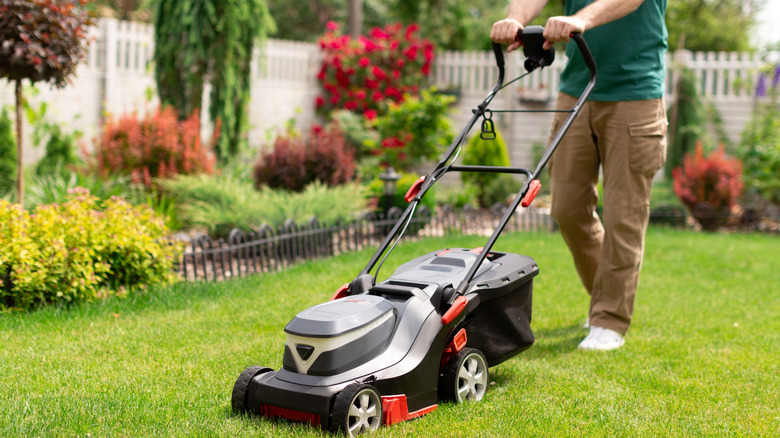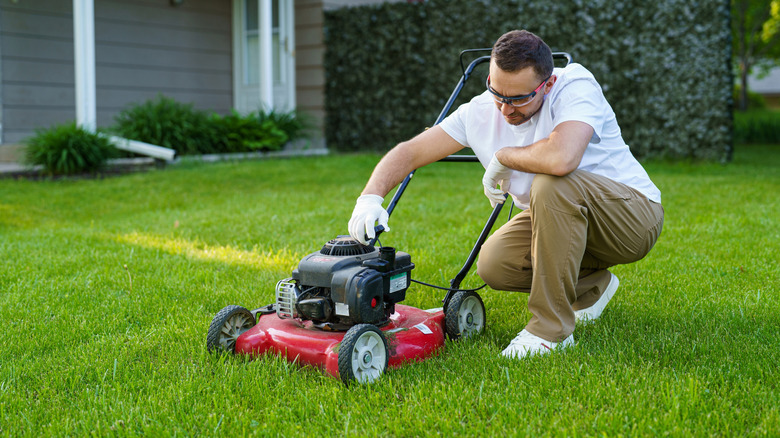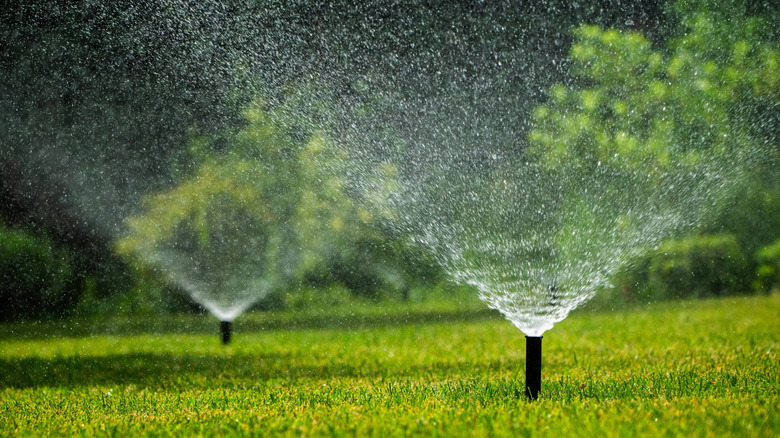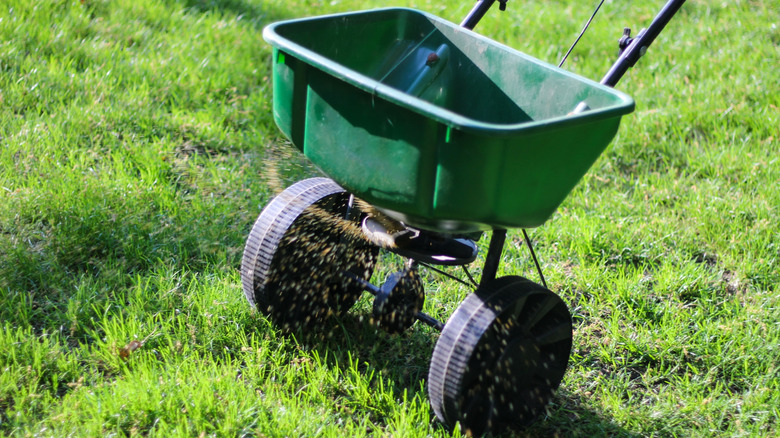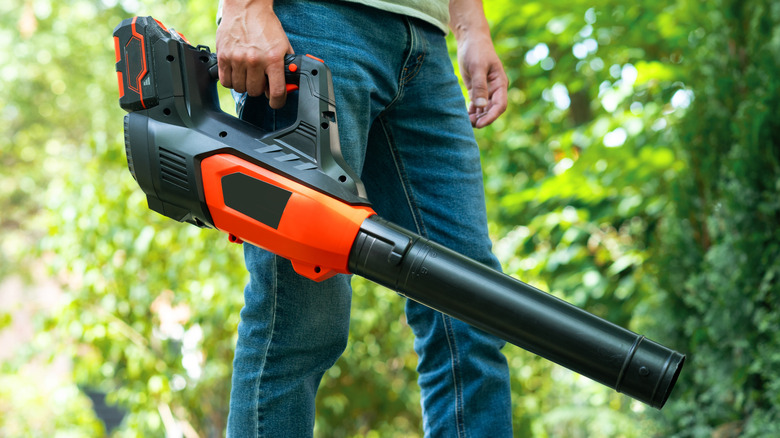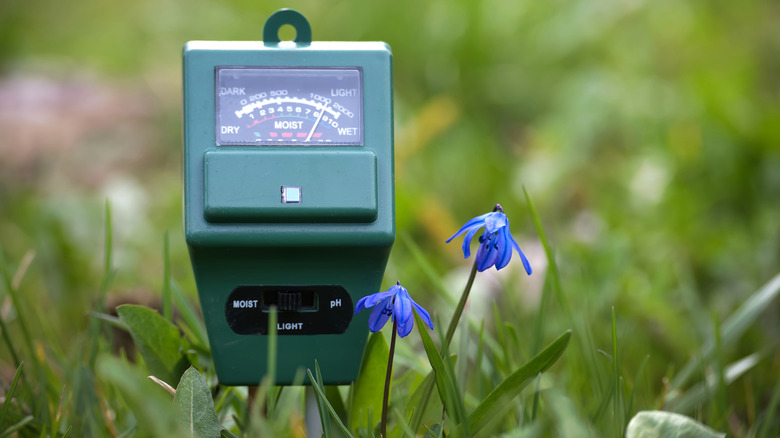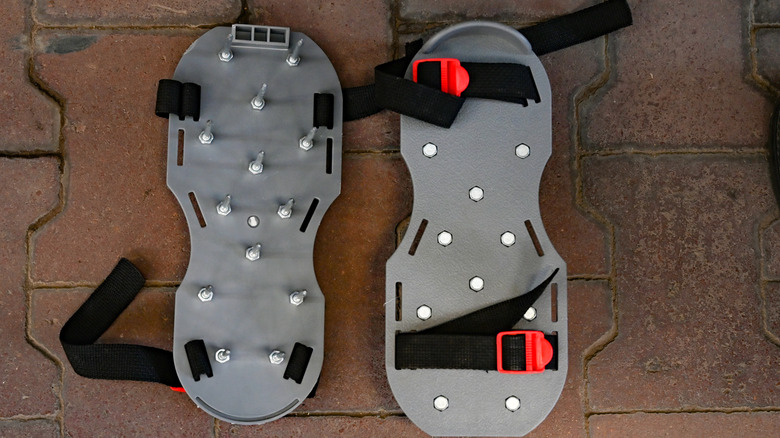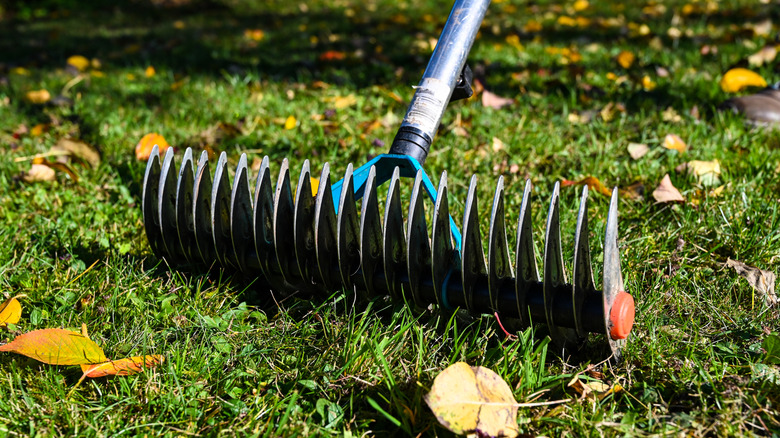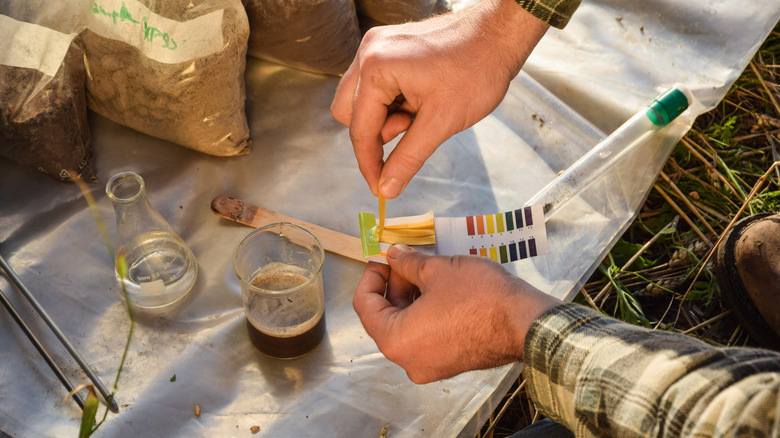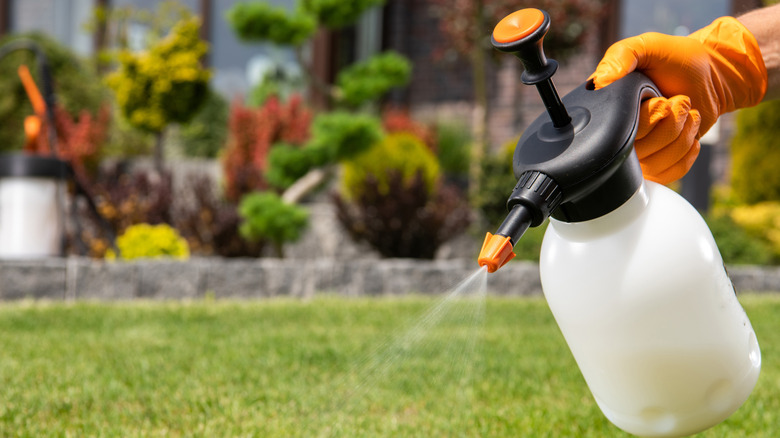11 Essential Lawn Tools For Healthy Green Grass
We may receive a commission on purchases made from links.
There are some essential lawn tools you need for a healthy, green lawn. While technique and effort are definitely part of the puzzle for a great outdoor space, sometimes you just can't get the results you want without using the right equipment, too. This list covers the basics of what everyone should have on hand, but also dives a bit deeper into specialized tools that solve specific grass problems. It also covers how to use the tools so you get the best results. As in, there is no use splashing out on a fancy new lawnmower if you trim your grass too short and kill it, or buying a dethatching rake if you're not really sure how it's different from a classic rake and just end up trying to use them the same way.
Whether you've been tending your lawn for years, or are living in a place with a yard for the very first time, treat this like a checklist to make sure you have what you need. Not in the place to buy new things right now? No worries! Many home and garden stores like the Home Depot and Lowe's allow you to rent tools, making even the biggest of yard projects a breeze, without blowing your budget.
A lawn mower with sharp blades
The baseline for keeping your grass healthy and green is a good lawnmower. Whether you choose a push mower or a riding option, the common denominator needs to be sharp blades. Much like a knife, you can sharpen your lawnmower blades by hand with a good file, like the WORKPRO W051002 Flat File. You don't even need to take them off to do it, but it definitely makes it easier. Sharpen them once for roughly every 25 hours of mowing time, or twice per season, whichever is more often. Set your blade to leave the grass about 2 to 3 inches high after mowing.
A sharp grass cut that isn't too short promotes healthy grass. It helps prevent lawn diseases because it reduces trapped moisture, controls weed growth by lower their chances of spreading, and makes it so that the roots of the grass can get enough air, which in turns helps protect against fungal infections. All of these things makes sure your grass stays healthy, lush, and green. The Ego LM2156SP Power+ 21″ Select Cut XP Mower comes highly recommended, because it's quieter than a gas mower and easy to use, while the Honda HRX217VKA Lawn Mower also ranks highly because of its dual blade, making it easy to get a close cut.
A sprinkler system, either automated or manual
A sprinkler is one of the most effective tools for keeping grass lush! Without regular watering, lawns can become dry and patchy. A sprinkler system helps make sure your lawn gets the right amount of water to stay healthy. An automated option might be more expensive to install, but it makes up for it with convenience. You can set it up to water early in the morning or late at night when less water will evaporate due to heat. This helps save water and allows the spray to soak deeper into the ground, reaching the roots of your grass. With timers and simple controls, these systems remove the need to guess when and how much to water, helping to avoid watering too much or too little, which can harm your lawn. You can hire a company for the installation, or DIY it, but either way, you'll need to prepare your lawn for the sprinkler system.
Manual sprinklers are a more budget-friendly option and still provide similar pros! They let you directly control when and where water is applied, making them great for spot-treating dry areas or newly seeded sections of the lawn. The Eden 96213 Lawn & Garden Essential Oscillating Sprinkler is a favorite because of the far reach of its spray.
A spreader to help with grass seeds and fertilizer, too
Lawns need fertilizer to thrive. Most fertilizer brands have essential nutrients like nitrogen, potassium, and phosphorus that help grass to grow thicker, greener, and healthier. Over time, soil naturally loses these nutrients due to mowing, regular watering, rainfall, heat from the sun, etc. When you fertilize your yard, you're replenishing what's been lost. This helps the grass develop strong roots, better resist pests and disease, and outcompete weeds. Without proper feeding, lawns can become thin, patchy, and discolored — which is certainly not the look you are going for! It's the same with grass seeds, too. Sometimes your lawn might need a touch-up to stay dense.
If you try to spread fertilizer or grass seed by hand, you might end up with a patchy application. Fertilizer should never be handled with bare hands anyway, but even with the best gardening gloves, you're still not looking at the ideal distribution if you're covering your entire yard. This is where a spreader comes in. It's a simple bucket tool that makes sure whatever it is that you're spreading distributes evenly. All you have to do is dump the product into the bucket and walk, and the small spinning arm at the bottom does the rest of the work. The Scotts Turf Builder EdgeGuard Mini Broadcast Spreader is popular, as is the Scotts Whirl Hand-Powered Spreader, if you prefer a smaller product that is handheld.
Two shovels, one big and one small
Going way back to basics, you need at least two shovels in your arsenal to keep your lawn looking its best. Best practice is keeping one larger shovel and one hand held around for various projects. For example, a small shovel (like the Fiskars Ergo Garden Trowel) is great for detailed work. If you need to dig carefully around a broken sprinkler head to fix it quickly without harming nearby grass, a small shovel helps you do it neatly. It's also useful for removing weeds. Since many weeds have deep or tough roots, pulling them out by hand can sometimes leave pieces behind that will allow the weed to grow back.
A larger shovel (like the Fiskars Garden Shovel) is best for heavier tasks, like removing entire plants or hauling a lot of dirt or mulch around. Adding a layer of mulch around the edges of your lawn or nearby garden beds helps keep the soil moist and prevents weeds from growing. This makes it easier for your grass to stay healthy because it doesn't have to compete with weeds for water. Using a big shovel can be useful when you want to change the shape of garden beds, smooth out uneven areas in your yard, or improve water drainage. All things that you can technically do it with a smaller shove or your hands, but it would take ages and wreck your back, too.
A rake and blower for easy clean up
A healthy, green lawn is one that isn't smothered in debris. Having a classic rake is great for easy clean up, like removing dead leaves, sticks, grass overflow from your lawnmower, and more. When you get rid of these, it's less likely that they will trap moisture on your grass, or block out the sunlight. Both of these things can create a breeding ground for pests, mold, and disease. If you remove the top layer of buildup, you can help your grass to breathe, get more sunlight, and therefore grow stronger. A blower is like a rake, but turbocharged! It gets all the waste off your patio and driveway, so it doesn't end up in your yard eventually. Sure, you can also sweep, but it takes a lot more time and physical effort, which is better spent elsewhere.
This Oliynedy Adjustable Metal Leaf Rake has an adjustable handle, making it easier for people of all heights to use it. If you want the kids to start helping out in the yard, there is a (fully functional) toy option, too, in the JustForKids Kids Garden Tool Set. For blowers, the LEAPUL 21V Cordless Electric Blower is fast charging and cordless, making it ideal for larger properties.
A soil moisture meter to test your lawn
A soil moisture meter is a surprisingly powerful tool when it comes to keeping your lawn at its best! This device helps you monitor one of the most important factors for lawn health: moisture. This way, you can prevent mistakes like watering too much or too little. Kind of like Goldilocks, grass needs just the right amount of moisture to stay healthy. Too much water can cause shallow roots, bugs, and wasted money on utility bills. Too little water makes the grass dry and eventually dead. Using a soil moisture meter gives you quick and easy information, so you can water your lawn at the right times, giving your grass exactly what it needs.
While they may seem like tools reserved for professionals, many regular folks are now also using them to get smarter about lawn care, just like golf courses do to maintain their famously lush, green turf. The XLUX Soil Moisture Meter can be used on potted plants or grass to let you know the exact moisture level of the soil. It's portable, so you can easily move it around to different sections of your yard, as well, to get a fuller picture of the overall water levels.
A soil aerator for good airflow
Aeration is essential for healthy grass! In fact, it's one of the hacks to steal from golf courses for a better lawn. Basically, when the soil in your yard gets too dense, it blocks water, oxygen, and nutrients from reaching the roots of the grass. This compaction makes it harder for your lawn to grow strong. Aerating creates small holes that let all these essentials go deeper into the ground, as compared to being blocked before. This access aids in better root development, helping grass stay green.
There are plenty of ways to DIY aerate your lawn. For example, you can use a tool you already own, like the DEWALT 20V Max Cordless Drill, to make holes in the grass about 3 inches deep and 6 inches apart. Yet, with a bigger lawn, this can easily become an exhausting, mammoth task. In this instance, consider using a soil aerator, like the Walensee Lawn Aerator Spike, which is a stick-like machine, or the Lawn Aerator with Velcro Fastener, which attaches to a pair of work boots (if you'd still like to get your steps in).
A string trimmer (aka weed whacker or weed eater) for all those hard to reach spots
A string trimmer is perfect for edging and cutting grass in hard-to-reach spots that mowers can't reach! While a lawn mower does the heavy lifting for wide open spaces, it often misses narrow, tricky areas, such as near fences, flower beds, tree trunks, and garden edges. That's where a string trimmer shines, preventing all the same problems as a lawn mower — just for smaller areas. That is, maintaining these tight corners and borders isn't just about appearances. It also contributes to your lawn's overall health, in that grass that grows unchecked in these hidden areas can become too dense, blocking sunlight and trapping moisture in ways that encourage pests or disease.
The EGO Power+ String Trimmer is a favorite, because of how long it lasts, making the chore much easier to complete in one go. The Worx GT Revolution 20V 12" String Trimmer works best for smaller yards, as it's more compact. A bit of a rogue choice, but if you don't want battery or gas-powered options, you can use a scythe, which is an ancient tool that still works just fine in the modern world, too. The traditional Austrian scythe is available to purchase online.
A dethatching rake to get rid of undergrowth
A dethatching rake is different than a classic rake, and they can't be used interchangeably. Unlike a regular rake, a dethatching rake is designed specifically to dig deep into your lawn and pull up layers of thatch. Thatch is a build-up of dead grass and other lawn debris that accumulates around the roots of grass. While a small amount of thatch is natural and even beneficial, too much of it (anything more than 1/2 inch or so) can start to smother your lawn. When this happens, your grass will suffer and the possibility of lawn diseases increases. Removing thatch with a dethatching rake opens up your lawn so it can breathe, absorb moisture more effectively, and respond better to the fertilizer you use.
So, while a regular rake is ideal for everyday cleanup from on top of your lawn, a dethatching rake is a more specialized tool for deeper down. You can see the difference in design on the BARAYSTUS Thatching Rake, as it has stiff, sharp metal tines that scrape and pull the thatch up, instead of thinner, slightly curved bits meant only for gathering. Using a dethatching rake regularly in place of a classic rake will cause damage to your lawn because of this, so only use it for its intended purpose when needed.
A pH and soil test kit to monitor the health of your grass
A pH and soil test kit is an essential tool because it gives you a clear picture of what's going on beneath the surface. Grass needs the right balance of nutrients and the right pH level (typically between 6.5 and 7.0 for most lawns) to absorb those nutrients effectively. Without that balance, even regular watering and fertilizing might not make much of a difference. For example, if a soil test reveals your lawn has a low pH (acidic), nutrients like nitrogen and phosphorus become less available to your grass. In that case, applying lime can raise the pH and help unlock those nutrients so your grass can actually use them. On the other hand, if your soil is too alkaline (above 7.5), you may need to add sulfur or iron to bring it back into the optimal range.
A soil test kit also shows you what nutrients are missing. Say your lawn is turning yellow or thinning out, and the test shows a nitrogen deficiency. This means you need to apply a nitrogen-rich fertilizer, instead of guessing and possibly overdoing it with a product your lawn doesn't need. The Rapitest Soil Test Kit is inexpensive and comes with glowing reviews, as does the MySoil Soil Test Kit.
A hose-end sprayer or pump sprayer for liquid lawn products
When you need to apply liquid fertilizers, herbicides, or pest control products evenly to care for your lawn, you need to grab a hose-end sprayer or pump sprayer. These tools take all of the hassle out of the application, making the task easier. They do this by measuring exact amounts of product, having adjusting spray patterns (from misting to targeted stream) for different distribution needs, and also by helping to avoid overspray with a hose. Using a sprayer also allows you to buy more cost-effective concentrated products and dilute them yourself, instead of buying massive amounts of product each time. All these features make your grass healthier.
The D.B. Smith Contractor 190216 2-Gallon Sprayer is a top choice among professionals for a reason: It's durable, well-sealed to prevent leaks, and thoughtfully designed for comfort and ease of use. Its 2-gallon capacity also means fewer refills, making it ideal for larger yards. On the other hand, the Chapin 20000 1-Gallon Lawn and Garden Pump Pressured Sprayer offers solid performance at a much more affordable price point. It's perfect for budget-conscious gardeners tackling smaller areas or occasional spot treatments.
